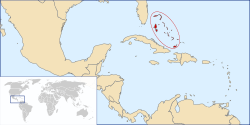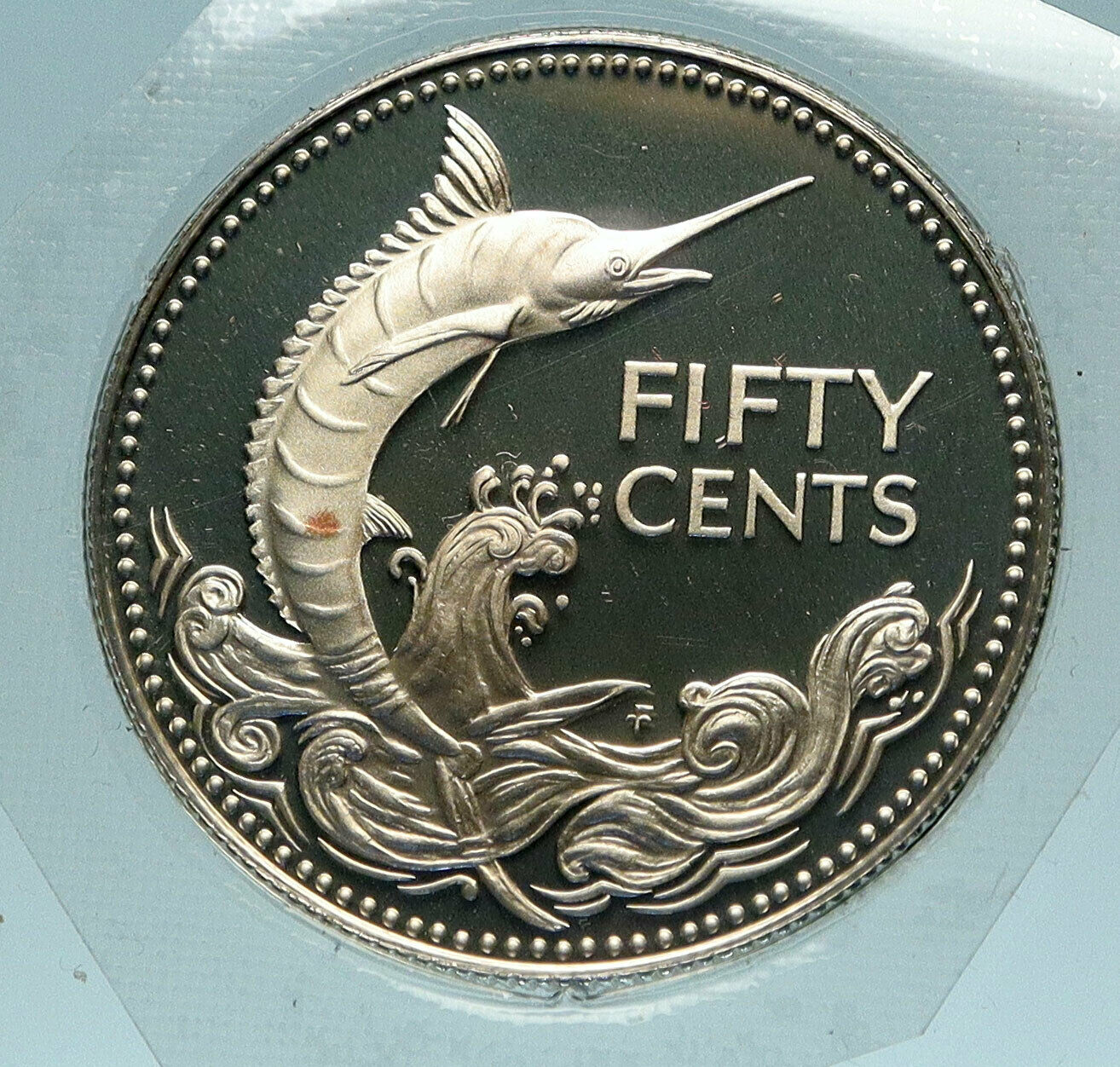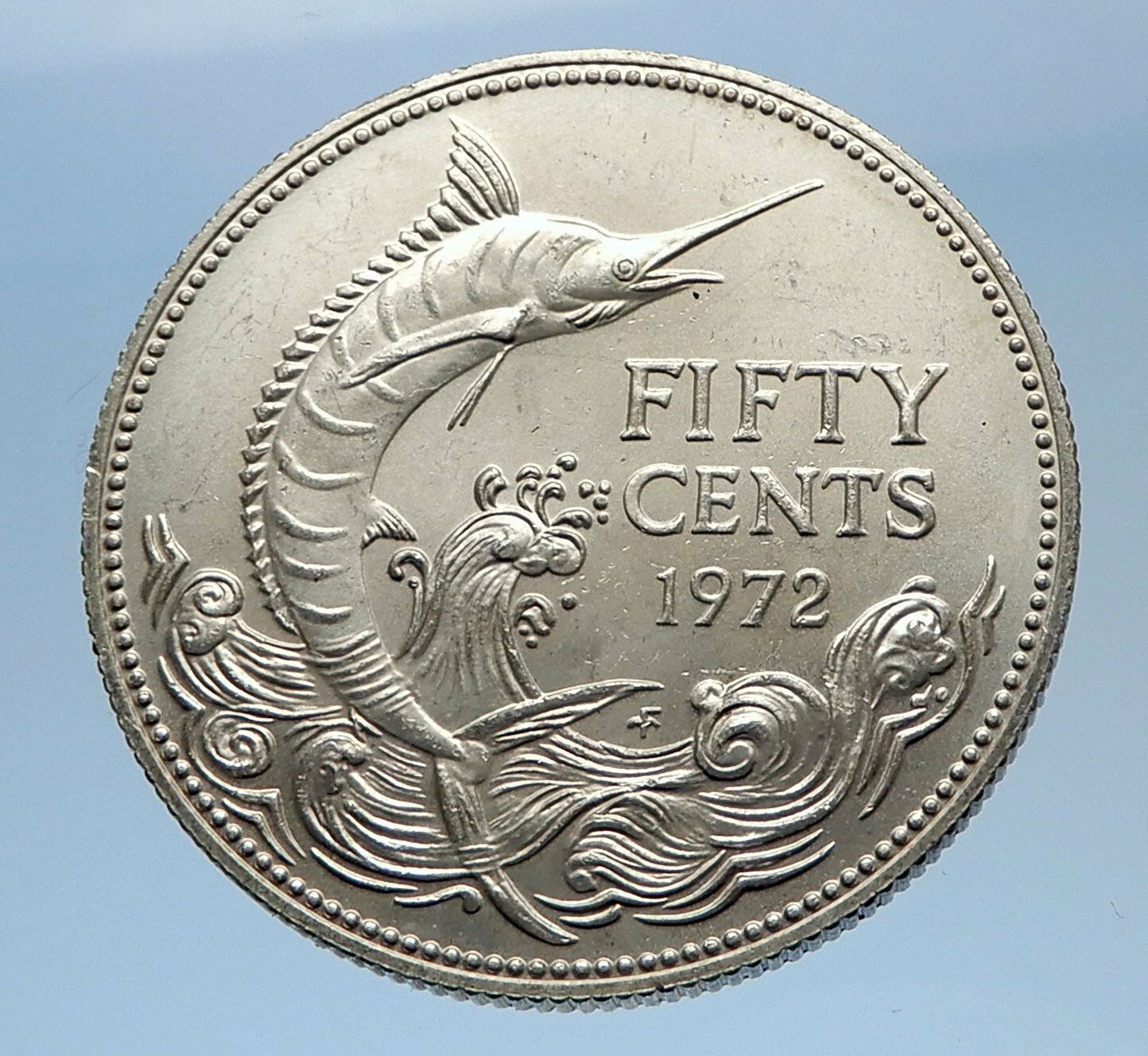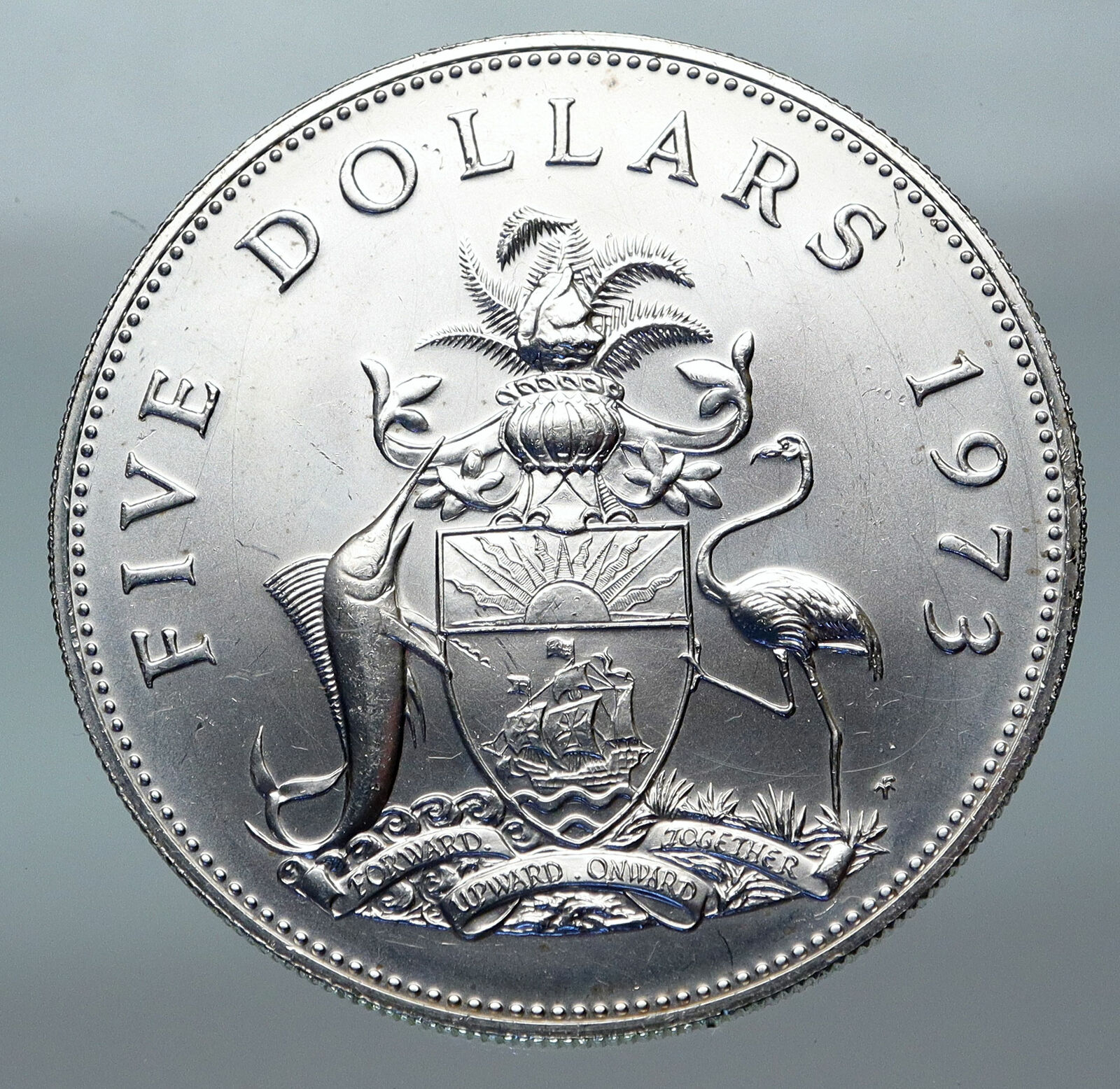|
Bahamas
1978 Proof Silver 2 Dollars 40mm (29.04 grams) 0.925 Silver (0.885 oz. ASW)
Reference: KM# 66 (1974-1980*)
COMMONWEALTH OF THE BAHAMA ISLANDS, Bahamas National Arms.
TWO DOLLARS, The national bird, two flamingos.
You are bidding on the exact item pictured, provided with a Certificate of Authenticity and Lifetime Guarantee of Authenticity.
 Flamingos or flamingoes are a type of wading bird in the family Phoenicopteridae, the only family in the order Phoenicopteriformes. There are four flamingo species in the Americas and two species in the Old World. Flamingos or flamingoes are a type of wading bird in the family Phoenicopteridae, the only family in the order Phoenicopteriformes. There are four flamingo species in the Americas and two species in the Old World.
Flamingo comes from Portuguese or Spanish flamengo, “flame-colored”, in turn coming from Provençal flamenc from flama “flame” and Germanic-like suffix -ing, with a possible influence of words like Fleming. A similar etymology has the Latinate Greek term Phoenicopterus (from Greek: φοινικόπτερος phoinikopteros), literally “blood red-feathered”.
  The Bahamas, officially the Commonwealth of the Bahamas, is an archipelagic state of the Lucayan Archipelago consisting of more than 700 islands, cays, and islets in the Atlantic Ocean; north of Cuba and Hispaniola (Haiti and the Dominican Republic); northwest of the Turks and Caicos Islands; southeast of the US state of Florida and east of the Florida Keys. Its capital is Nassau on the island of New Providence. The designation of “The Bahamas” can refer to either the country or the larger island chain that it shares with the Turks and Caicos Islands. As stated in the mandate/manifesto of the Royal Bahamas Defence Force, the Bahamas territory encompasses 470,000 km2 (180,000 sq mi) of ocean space. The Bahamas, officially the Commonwealth of the Bahamas, is an archipelagic state of the Lucayan Archipelago consisting of more than 700 islands, cays, and islets in the Atlantic Ocean; north of Cuba and Hispaniola (Haiti and the Dominican Republic); northwest of the Turks and Caicos Islands; southeast of the US state of Florida and east of the Florida Keys. Its capital is Nassau on the island of New Providence. The designation of “The Bahamas” can refer to either the country or the larger island chain that it shares with the Turks and Caicos Islands. As stated in the mandate/manifesto of the Royal Bahamas Defence Force, the Bahamas territory encompasses 470,000 km2 (180,000 sq mi) of ocean space.
 The Bahamas were the site of Columbus’ first landfall in the New World in 1492. At that time, the islands were inhabited by the Lucayan, a branch of the Arawakan-speaking Taino people. Although the Spanish never colonised the Bahamas, they shipped the native Lucayans to slavery in Hispaniola. The islands were mostly deserted from 1513 until 1648, when English colonists from Bermuda settled on the island of Eleuthera. The Bahamas were the site of Columbus’ first landfall in the New World in 1492. At that time, the islands were inhabited by the Lucayan, a branch of the Arawakan-speaking Taino people. Although the Spanish never colonised the Bahamas, they shipped the native Lucayans to slavery in Hispaniola. The islands were mostly deserted from 1513 until 1648, when English colonists from Bermuda settled on the island of Eleuthera.
The Bahamas became a British Crown colony in 1718, when the British clamped down on piracy. After the American War of Independence, the Crown resettled thousands of American Loyalists in the Bahamas; they brought their slaves with them and established plantations on land grants. Africans constituted the majority of the population from this period. The Bahamas became a haven for freed African slaves: the Royal Navy resettled Africans here liberated from illegal slave ships; American slaves and Seminoles escaped here from Florida; and the government freed American slaves carried on United States domestic ships that had reached the Bahamas due to weather. Slavery in the Bahamas was abolished in 1834. Today the descendants of slaves and free Africans make up nearly 90% of the population; issues related to the slavery years are part of society.
The Bahamas became an independent Commonwealth realm in 1973, retaining Queen Elizabeth II as its monarch. In terms of gross domestic product per capita, the Bahamas is one of the richest countries in the Americas (following the United States and Canada). Its economy is based on tourism and finance.
|





 Flamingos or flamingoes are a type of wading bird in the family Phoenicopteridae, the only family in the order Phoenicopteriformes. There are four flamingo species in the Americas and two species in the Old World.
Flamingos or flamingoes are a type of wading bird in the family Phoenicopteridae, the only family in the order Phoenicopteriformes. There are four flamingo species in the Americas and two species in the Old World.
 The Bahamas, officially the Commonwealth of the Bahamas, is an archipelagic state of the Lucayan Archipelago consisting of more than 700 islands, cays, and islets in the Atlantic Ocean; north of Cuba and Hispaniola (Haiti and the Dominican Republic); northwest of the Turks and Caicos Islands; southeast of the US state of Florida and east of the Florida Keys. Its capital is Nassau on the island of New Providence. The designation of “The Bahamas” can refer to either the country or the larger island chain that it shares with the Turks and Caicos Islands. As stated in the mandate/manifesto of the Royal Bahamas Defence Force, the Bahamas territory encompasses 470,000 km2 (180,000 sq mi) of ocean space.
The Bahamas, officially the Commonwealth of the Bahamas, is an archipelagic state of the Lucayan Archipelago consisting of more than 700 islands, cays, and islets in the Atlantic Ocean; north of Cuba and Hispaniola (Haiti and the Dominican Republic); northwest of the Turks and Caicos Islands; southeast of the US state of Florida and east of the Florida Keys. Its capital is Nassau on the island of New Providence. The designation of “The Bahamas” can refer to either the country or the larger island chain that it shares with the Turks and Caicos Islands. As stated in the mandate/manifesto of the Royal Bahamas Defence Force, the Bahamas territory encompasses 470,000 km2 (180,000 sq mi) of ocean space. The Bahamas were the site of Columbus’ first landfall in the New World in 1492. At that time, the islands were inhabited by the Lucayan, a branch of the Arawakan-speaking Taino people. Although the Spanish never colonised the Bahamas, they shipped the native Lucayans to slavery in Hispaniola. The islands were mostly deserted from 1513 until 1648, when English colonists from Bermuda settled on the island of Eleuthera.
The Bahamas were the site of Columbus’ first landfall in the New World in 1492. At that time, the islands were inhabited by the Lucayan, a branch of the Arawakan-speaking Taino people. Although the Spanish never colonised the Bahamas, they shipped the native Lucayans to slavery in Hispaniola. The islands were mostly deserted from 1513 until 1648, when English colonists from Bermuda settled on the island of Eleuthera.




